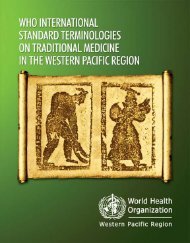The Philippines Health System Review - WHO Western Pacific ...
The Philippines Health System Review - WHO Western Pacific ...
The Philippines Health System Review - WHO Western Pacific ...
- No tags were found...
Create successful ePaper yourself
Turn your PDF publications into a flip-book with our unique Google optimized e-Paper software.
From 2006-2012 the country averaged just under five per cent annual GDPgrowth (albeit with some major fluctuations), at par with the region (ADB2011). <strong>The</strong> Gini coefficient decreased from 0.49 in 1997 to 0.46 in 2006,indicating that great economic inequality persists. Employment rateswere below 90% in the years 2000 to 2005, but have risen to 92.4% in2009. <strong>The</strong> underemployment rate, on the other hand, was 19.8%.As of 2006, the National Capital Region (NCR) had the highest averageannual family income of Php 310 860 (US$ 6058) (Table 1-3). RegionIV-A and the Cordillera Administrative Region (CAR) are also among thehighest earning regions. Conversely, the poorest region based on averageannual family income is the Autonomous Region in Muslim Mindanao(ARMM), whose families earn less than a third of those in NCR, followedby Region IV-B and Region XII.1.3 Political ContextSince 1897, the <strong>Philippines</strong> has had seven constitutions. <strong>The</strong> latestratified by referendum in 1987 and now in effect, established a republicangovernment patterned after that of the United States with a strongexecutive branch, a bicameral legislature, and an independent judiciaryunder a supreme court.<strong>The</strong> executive branch through the national government agencies and localgovernment units exercises administrative and/or regulatory authorityover the health system as a whole. <strong>The</strong> legislative branch influences thehealth system in two ways: a) by approving the annual budgets of nationalhealth agencies and institutions; and b) by individual congressmenallocating their “development funds” (PDAF or “pork barrel”) to specifichealth institutions for various purposes. <strong>The</strong> judiciary affects the healthsystem in both the government and private sectors when it rendersdecisions in legal disputes involving health agencies, institutions andindividuals.1.4 <strong>Health</strong> StatusPhilippine health status indicators show that the country lags behindmost of South-East and North Asia in terms of health outcomes. Whilerapid improvements were seen during the last three decades, these haveslowed in recent years.6
















